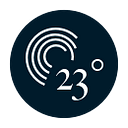#Howto: change the value range of a chart axis or map legend | EN/GER
####Für Deutsche Version nach unten scrollen####
Visit us at: app.23degrees.io
When I create a graphic with 23°, I have 3 different options to display the “Value Range”, i.e. the displayed value range of the axes in charts or the legend on the map.
Click on the pen icon to open the editor. You will find the “Value Range” settings at the bottom of the “Visual” section.
There are three different options to display the “Value Range”
1) Complete data table
If you choose this setting the complete value range is shown on the axis of the chart or on the map legend. This could mean that those values which are not visible in the actual chart or map because they are hidden -for example through a filter- will still show up on the axis or the legend.
2) Currently visible values
The values that are actually active are taken into account here. For example, if you have created a graphic that is filtered by years, you will get a new value range with different values on the axis for each year. You can see in the GIF below how the values on the axis adjust according to the values of each selected year.
3) Custom selection
Here you can set custom values. Click on the “Value Range” tab and select “Custom selection”. Then enter the min. and max. values in the field.
Write us: office@23degrees.io
twitter: @23degrees_io
fb: @23degrees.io
ig: @23degrees_io
############GERMAN VERSION###############
Wenn ich eine Grafik mit 23degrees erstelle, habe ich 3 verschiedene Möglichkeiten, die “Value Range”, also den angezeigten Wertebereich der Achsen in den Charts bzw. der Legende in der Karte anzeigen zu lassen.
Klicke im Editor, im Bereich “Visual” auf “Value Range” .
1) Complete data table
Hier wird der komplette Wertebereich in den Achsen oder der Legende dargestellt. Das heißt auch jene Werte, welche z.B. durch einen Filter in der Grafik gerade nicht sichtbar sind. Hast du beispielsweise ein Grafik mit einem Zeitreihen Filter bleibt der Min. und Max. Wert der Achsen gleich.
2) Currently visible values
Hier werden jene Werte berücksichtigt, die tatsächlich gerade aktiv sind. Hast du zum Beispiel eine Grafik erstellt, in der nach Jahren gefiltert wird, erhältst du für jedes Jahr, einen neuen Wertebereich mit anderen Werten. Siehe im GIF unten, wie sich die Werte in der Achse mit jedem ausgewählten Jahr neu anpassen.
3) Custom selection
Hier kannst du selbst einstellen, welche Werte angezeigt werden sollen. Klicke hierzu auf den Reiter beim Punkt “Value Range” und wähle “Custom selection”. Gib dann im Feld die Min. und Max. Werte ein.
